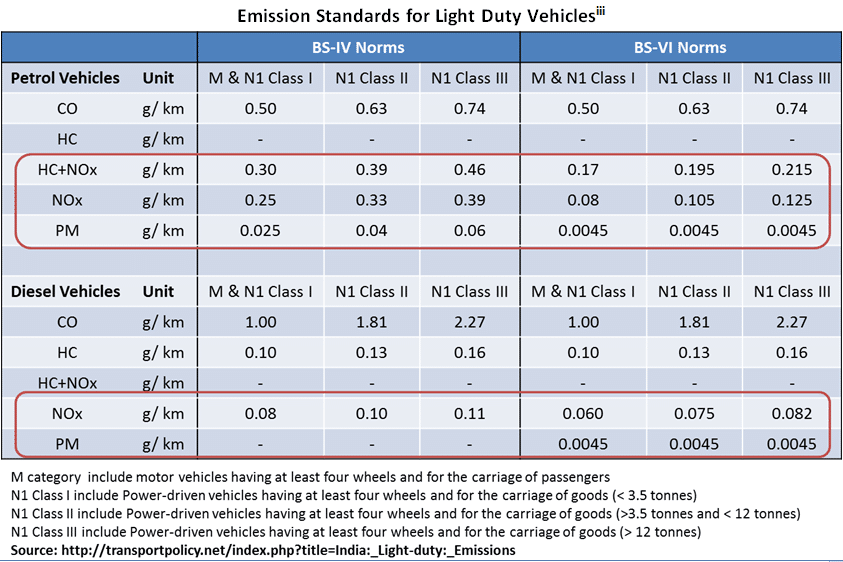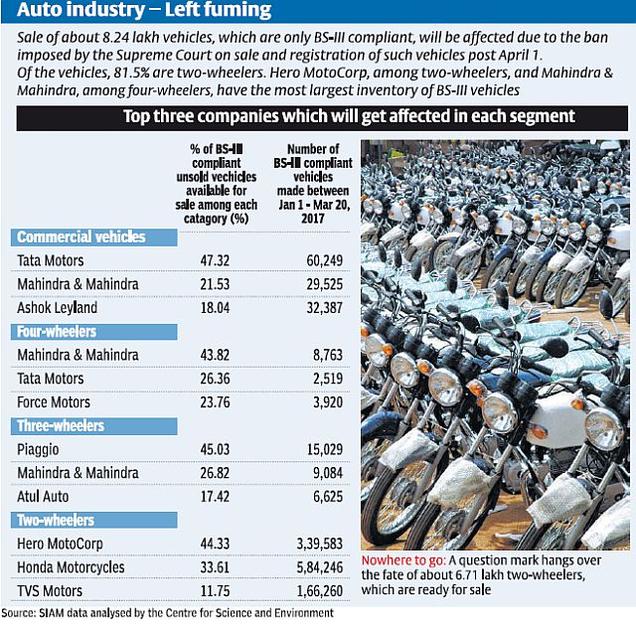BS-VI is one of the newest Bharat Stage Emission Standards (BSES) that would come into effect from April 1, 2020. Supreme Court has banned sale and production of vehicles with BS III engines after 1 April 2017. Only vehicles having engines of BS-IV can be sold and manufactured after April 1. What are BS III standards? Why did Supreme Court ban it? What impact it will have
Our article BS4 to BS6 Vehicle: Which one should you buy? Fuel, Ban, Emission covers BS VI and BS IV in detail.
Table of Contents
Overview of the Ban on BS III Vehicles and their impact
Supreme Court has banned sale and production of vehicles with BS III engines after 1 April 2017. Motorcycles, scooters, trucks, buses and three-wheelers are affected by the order. All cars have already been upgraded to BS-IV norm
What are BS Emission Standards?
BS or Bharat stage emission standards are emission standards instituted by the Government of India to regulate the output of air pollutants from internal combustion engine equipment, including motor vehicles. Bharat Stage emission norms (equivalent to Euro norms for four-wheeled vehicles) were first introduced in 2000. These norms specify the maximum permissible emission limit for carbon monoxide (CO), hydrocarbons (HC), nitrous oxides (NOx) and particulate matter (PM).
The Difference in Nitrogen Oxide (as prime contributor for Air Pollution)
- NOX in BS – 3 Compliant Petrol Cars is 150 milligram / km while in BS – 4 Cars is 80 milligram / Km
- NOX in BS – 3 Compliant Diesel Cars is 500 milligram / km while in BS – 4 Cars is 250 milligram / Km
Story of vehicle emission controls began in India when mass emission norms were enforced for the first time for petrol vehicles in 1991 and for diesel vehicles in 1992. Emission norms were further tightened in 1996 with the compulsory fitment of catalytic converters in petrol cars. The standards and the timeline for implementation are set by the Central Pollution Control Board under the Ministry of Environment & Forests and climate change
- Since October 2010, Bharat Stage (BS) III norms have been enforced across the country.
- In 13 major cities, Bharat Stage IV emission norms have been in place since April 2010. It’s enforced for whole country from 1 April 2017.
- In 2016, the Indian government announced that the country would skip the BS-V norms altogether and adopt BS-VI norms by 2020
| Standard | Reference | YEAR | Region |
|---|---|---|---|
| India 2000 | Euro 1 | 2000 | Nationwide |
| Bharat Stage II | Euro 2 | 2001 | NCR*, Mumbai, Kolkata, Chennai |
| 2003.04 | NCR*, 13 Cities† | ||
| 2005.04 | Nationwide | ||
| Bharat Stage III | Euro 3 | 2005.04 | NCR*, 13 Cities† |
| 2010.04 | Nationwide | ||
| Bharat Stage IV | Euro 4 | 2016.04 | NCR*, 13 Cities† |
| 2017.04 | Nationwide | ||
| Bharat Stage V | Euro 5 | (to be skipped) | |
| Bharat Stage VI | Euro 6 | 2020.04 (proposed) | Entire country |
| * National Capital Region (Delhi)† Mumbai, Kolkata, Chennai, Bengaluru, Hyderabad, Ahmedabad, Pune, Surat, Kanpur, Lucknow, Sholapur, Jamshedpur and Agra | |||
The above standards apply to all new 4-wheel vehicles sold and registered in the respective regions. In addition, the National Auto Fuel Policy introduces certain emission requirements for interstate buses with routes originating or terminating in Delhi or the other 10 cities.
Progress of emission standards for 2-and 3-wheelers:
| Standard | Reference | Date |
|---|---|---|
| Bharat Stage II | Euro 2 | 1 April 2005 |
| Bharat Stage III | Euro 3 | 1 April 2010 |
| Bharat Stage IV | Euro 4 | 1 April 2017 |
| Bharat Stage VI | Euro 6 | April 2020 (proposed) |
In order to comply with the BSIV norms, 2- and 3-wheeler manufacturers will have to fit an evaporative emission control unit, which should lower the amount of fuel that is evaporated when the vehicle is parked
Comparison of Bharat Stage and Euro norms
The Bharat Stage norms have been styled to suit specific needs and demands of Indian conditions. The differences lie essentially in environmental and geographical needs, even though the emission standards are the same.
- Temperatures: Euro-III is tested at sub-zero temperatures in European countries. In India, where the average annual temperature ranges between 24 and 28 °C, the test is done away with.
- Speed: A speed of 90 km/h is stipulated for BS-III, whereas it is 120 km/h for Euro-III, keeping emission limits the same in both cases.
- Test procedure: For instance, the mass emission test measurements done in g/km on a chassis dynamometer requires a loading of 100 kg weight in addition to unloaded car weight in Europe. In India, BS-III norms require an extra loading of 150 kg weight to achieve the desired inertia weight mainly due to road conditions here.
Why the Ban on BS 3 Vehicles?
India has the most polluted cities in the world. 30 Indian cities figure in the Top 100 Most Polluted Global Cities (in terms of particulate matter PM10) as per data published by World Health Organization in May 2016. Air pollution is the fifth leading cause of death in India. In the capital city of Delhi, vehicles contribute 59%, 50% and 18% of the overall emissions of carbon monoxide, hydrocarbons and nitrous oxides respectively.
There is a strong opinion emerging among policy makers and environmental groups in India that stricter emission standards need to be implemented for all kind of vehicles in the country.
How BS 3 Ban going to Impact Vehicle Owners
BS 3 Ban Impact not going to Impact Existing Vehicle Owners in Plying it on Roads, They can continue driving there cars in without any Issues or can sell Car in Home City / State to other Person at Ease and in event of Sale – its Name Transfer happens without any re-registration.
The Impact of BS-III Ban though however will be limit sales of vehicles to within state only as there is no re-registration.
- Sale of BS – 3 Vehicles in any other State other than Home State / Union Territory This is due to the fact that Vehicle needs to be Re-registered with a new registration Mark in Other State. Now as Supreme Court put a Ban on both Sale and Registration of BS 3 Vehicles – the stated vehicle can not be re-registered due to same
- Transfer to Other State: If you are Transferred to other State due to Job for more than a year or Settling down Permanently, you would not be able to take your BS – 3 Compliant Car in New State due to Ban on re-registration of Such Cars
- Impact on Resale Value: Though this is something which is Notional – but considering regions like NCR – where Vehicle Owners used to get Buyers from Noida, Faridabad, Gurgaon, Delhi too for registered Cars in any of Zone for Better Price Discovery. For instance – Gurgaon Car Owner selling Car and a Delhi buyer purchasing same and re-registering it. The Gurgaon Car Owner can only sell it within Haryana i.e Faridabad and Gurgaon. This will impact in Resale Factor to an Extent as Buyer Set is Limited to within State only.
How BS 3 Ban going to Impact Vehicle Manufacturers
Manufacturers have to liquidate their BS-III stock before end of March 31 as they will become obsolete after that. So Manufacturers are giving away huge discounts on BS-III vehicles to the tune of 5-15 percent. These are up to four times higher than normal discounting levels. The phasing out of 2-stroke engine for two wheelers, the cessation of production of Maruti 800 & introduction of electronic controls have been due to the regulations related to vehicular emissions.
Related Articles:
- Understanding Car : Box,Segment,Specifications
- Understanding Ex Showroom Price and On Road Price of Vehicle
- BS4 to BS6 Vehicle: Which one should you buy? Fuel, Ban, Emission
- Cost of owning a Car
- What is Car Insurance
- How to close Car Loan?







Nice Sharing.Thanks for sharing with us.it is new for me.